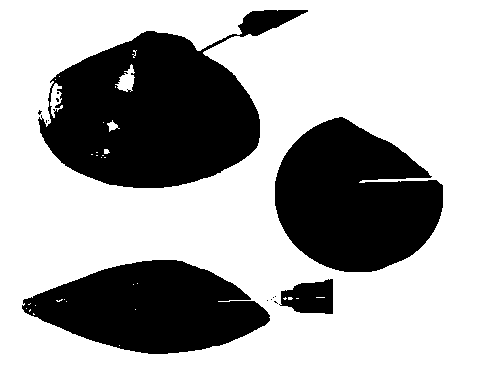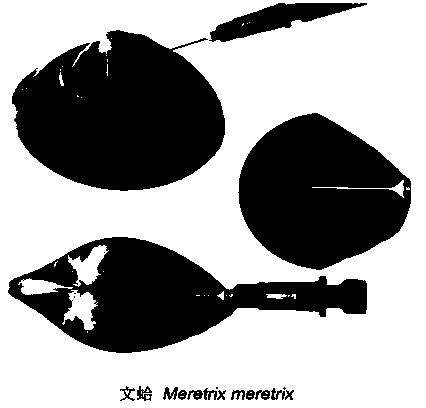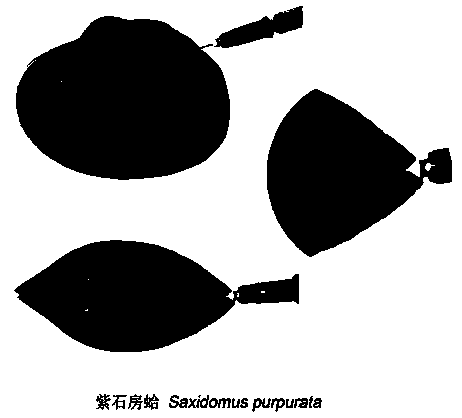Sex identification method for veneridae shellfish parents
An identification method, the technology of the clam family, which is applied in the direction of biochemical equipment and methods, and the determination/inspection of microorganisms, can solve the problems of unfavorable identification of individual survival, increase of test cost, cumbersome experimental process, etc., and achieve a simple and easy identification process , scientific research is of great significance, and the effect of broad market prospects
- Summary
- Abstract
- Description
- Claims
- Application Information
AI Technical Summary
Problems solved by technology
Method used
Image
Examples
Embodiment 1
[0019] In 2013, in the Engineering Technology Research Center of Shellfish Breeding in Liaoning Province, the sex of the equilateral clam was identified by the method disclosed in the present invention. Such as figure 1 shown.
[0020] First prepare a disposable sterile syringe with a volume of 1mL; prepare an equilateral clam to be identified, and determine the point where the end of the external ligament of the equilateral clam meets the edge of the shell. This point is the collection point. Hold it firmly with your left hand For equilateral clams, aim the needle tip of the syringe at the collection point with the right hand, adjust the tangent angle between the needle tip and the edge of the shell to be 35 degrees, send the needle tip of the syringe into the soft body of the equilateral clam, and let the needle tip enter according to the size of the equilateral clam. The position of the gonads of the equilateral shallow clam, sucking samples;
[0021] Put the sample taken...
Embodiment 2
[0024] In 2013, at the Engineering Technology Research Center of Shellfish Breeding in Liaoning Province, the clam sex was identified by the method disclosed in the present invention. Such as figure 2 shown.
[0025] First, prepare an ordinary syringe with a volume of 1mL, and sterilize it; prepare the clam to be identified, and determine the point where the end of the outer ligament of the clam meets the edge of the shell. This point is the collection point. Hold the clam firmly with your left hand, and Aim the needle point of the syringe at the collection point, adjust the tangent angle between the needle point and the edge of the shell to be 55 degrees, send the needle point of the syringe into the soft body of the clam, let the needle point enter the gonad of the clam according to the size of the clam, and draw the sample;
[0026] Put the sample taken out on a glass slide that has been dripped with seawater beforehand, and then observe the shape of the sample under a mi...
Embodiment 3
[0029] In 2013, at the Liaoning Provincial Shellfish Breeding Engineering Technology Research Center, the sex of the clam was identified by the method disclosed in the present invention. Such as image 3 shown.
[0030] First, prepare a disposable sterile syringe with a volume of 1mL; prepare the clam to be identified, and determine the point where the end of the outer ligament of the clam meets the edge of the shell. This point is the collection point. Hold the clam firmly with your left hand. For clams, point the needle tip of the syringe at the collection point with the right hand, adjust the tangent angle between the needle tip and the edge of the shell to be 45 degrees, send the needle tip of the syringe into the soft body of the clam, and let the needle tip enter the purple clam according to the size of the clam. The location of the gonads of the clam, taking samples;
[0031] Put the sample taken out on a glass slide that has been dripped with seawater beforehand, and...
PUM
 Login to View More
Login to View More Abstract
Description
Claims
Application Information
 Login to View More
Login to View More - R&D
- Intellectual Property
- Life Sciences
- Materials
- Tech Scout
- Unparalleled Data Quality
- Higher Quality Content
- 60% Fewer Hallucinations
Browse by: Latest US Patents, China's latest patents, Technical Efficacy Thesaurus, Application Domain, Technology Topic, Popular Technical Reports.
© 2025 PatSnap. All rights reserved.Legal|Privacy policy|Modern Slavery Act Transparency Statement|Sitemap|About US| Contact US: help@patsnap.com



